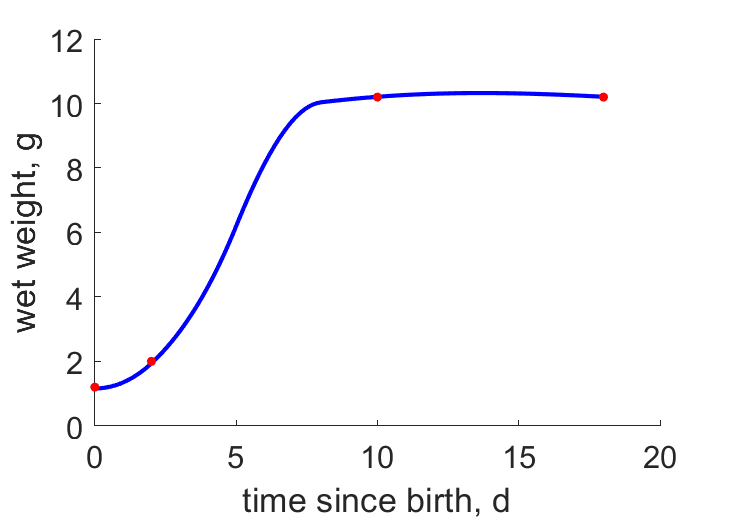Predictions & Data for this entry
| Model: std | climate: Am | migrate: | phylum: |
| COMPLETE = 2.5 | ecozone: TOh | food: biCi, biHn, biHs | class: |
| MRE = 0.017 | habitat: 0iTf | gender: Dg | order: |
| SMSE = 0.001 | embryo: Tnpf | reprod: O | family: |
Zero-variate data
| Data | Observed | Predicted | (RE) | Unit | Description | Reference |
|---|---|---|---|---|---|---|
| ab | 14 | 15.1 | (0.07849) | d | age at birth | Leps2020 |
| tx | 18 | 18.02 | (0.001018) | d | time since birth at fledging | Leps2020 |
| tp | 54 | 52.94 | (0.01965) | d | time since birth at puberty | guess |
| tR | 365 | 365 | ( 0) | d | time since birth at 1st brood | avibase |
| am | 3468 | 3444 | (0.006873) | d | life span | avibase |
| Ww0 | 3.66 | 1.679 | (0.5412) | g | initial wet weight | avibase |
| Wwb | 1.2 | 1.157 | (0.03602) | g | wet weight at birth | Leps2020 |
| Wwi | 10.3 | 10.49 | (0.01806) | g | ultimate wet weight | avibase |
| Wwim | 10 | 9.957 | (0.004271) | g | ultimate wet weight for males | avibase |
| Ri | 0.008219 | 0.008148 | (0.008618) | #/d | maximum reprod rate | AnAge |
Uni- and bivariate data
| Data | Figure | Independent variable | Dependent variable | (RE) | Reference |
|---|---|---|---|---|---|
| tW |  | time since birth | wet weight | (0.005218) | Leps2020 |
Pseudo-data at Tref = 20°C
| Data | Generalised animal | Magumma parva | Unit | Description |
|---|---|---|---|---|
| v | 0.02 | 0.03364 | cm/d | energy conductance |
| p_M | 18 | 353.2 | J/d.cm^3 | vol-spec som maint |
| k_J | 0.002 | 0.01439 | 1/d | maturity maint rate coefficient |
| k | 0.3 | 0.2984 | - | maintenance ratio |
| kap | 0.8 | 0.9503 | - | allocation fraction to soma |
| kap_G | 0.8 | 0.7996 | - | growth efficiency |
| kap_R | 0.95 | 0.95 | - | reproduction efficiency |
Discussion
- males are assumed to differ from females by {p_Am} only
- Ww0 is ignorned due to inconsistency with Wwb
- mod_1: v is reduced
- mod_2: Pseudo-data point k is used, rather than k_J; Data set tp and parameter t_R are added, the latter replacing clutch interval t_N. Postnatal T is based on PrinPres1991, see get_T_Aves. See further the revision page, theme puberty
Bibliography